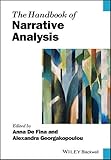The handbook of narrative analysis / edited by Anna De Fina & Alexandra Georgakopoulou.
Material type: TextPublisher number: EB00607357 | Recorded BooksSeries: Blackwell handbooks in linguisticsPublisher: Malden, MA : Wiley Blackwell, [2015]Description: 1 online resourceContent type:
TextPublisher number: EB00607357 | Recorded BooksSeries: Blackwell handbooks in linguisticsPublisher: Malden, MA : Wiley Blackwell, [2015]Description: 1 online resourceContent type: - text
- computer
- online resource
- 9781118458129 (ePub)
- 1118458125 (ePub)
- 9781118458181 (Adobe PDF)
- 1118458184 (Adobe PDF)
- 9781118458204
- 1118458206
- 111845815X
- 9781118458150
- Discourse analysis, Narrative -- Handbooks, manuals, etc
- Narration (Rhetoric) -- Handbooks, manuals, etc
- Discourse analysis, Narrative
- English fiction -- History and criticism
- Narration (Rhetoric)
- LANGUAGE ARTS & DISCIPLINES / Linguistics / General
- Discourse analysis, Narrative
- Narration (Rhetoric)
- Diskursanalys
- Narratologi
- Berättande
- 401/.41 23
- P302.7
Includes bibliographical references and index.
Description based on print version record and CIP data provided by publisher.
Title Page; Copyright Page; Contents; Transcription Conventions; Notes on Contributors; Introduction; Why a Handbook in Narrative Analysis?; From Narrative Analysis of Texts to the Analysis of Social Practices; Overview; References; Part I Narrative Foundations: Knowledge, Learning, and Experience; Chapter 1 Narrative as a Mode of Understanding: Method, Theory, Praxis; 1.1 Introduction; 1.2 Narrative Mania; 1.3 Narrative Excess; 1.4 Narrative Illusion; 1.5 Narrative as Method: Reading for Meaning; 1.6 Narrative as Theory: The Hermeneutics of Human Understanding.
1.7 Narrative as Praxis: From Big Stories to SmallReferences; Chapter 2 Story Ownership and Entitlement; 2.1 Introduction; 2.2 Story Ownership and Retellings; 2.3 Entitlement in Conversation; 2.4 Story Ownership, Authoritative Discourse, and Reported Speech; 2.5 Speaking for Others: Problems of Representation; 2.6 Speaking on Behalf of Another: Advocacy and Exploitation; 2.7 Disclosure/Non-disclosure; 2.8 Cultural Rules for Ownership and Tellability; 2.9 Questions of Belonging and Ownership; 2.10 Credibility, Story Ownership, and Genre; 2.11 The Obligation to Tell/Speak.
2.12 Silence, the Unspeakable, and the Illegible2.13 Conclusion; Notes; References; Chapter 3 Narrating and Arguing: From Plausibility to Local Moves; 3.1 Introduction; 3.2 Views on Everyday Argumentation and Reasoning; 3.3 The Importance of the Discourse of a Sociocultural Practice; 3.4 Arguing by Narrating; 3.5 Other Ways of Backing a Claim in, with, and across Narratives; 3.6 A Local Mechanism for the Effective Presentation of Claims; 3.7 The Special Case of "Why"; 3.8 Conclusions; References; Chapter 4 Narrative, Cognition, and Socialization; 4.1 Introduction; 4.2 L2 Narrative Development.
4.3 Content-based Narrative Analyses: Labovian Methodology4.4 Method; 4.5 Results; 4.6 Overall Discussion; 4.7 Conclusion and Future Perspectives; References; Chapter 5 Narrative Knowledging in Second Language Teaching and Learning Contexts; 5.1 Introduction; 5.2 Narrative Knowledging; 5.3 Analytical Approaches; 5.4 Learners -- Autobiographical Research; 5.5 Learners -- Biographical Research; 5.6 Teachers -- Autobiographical Research; 5.7 Teachers -- Biographical Research -- Professional Development; 5.8 Teachers -- Biographical Research -- Not Professional Development.
5.9 Teachers and Learners -- Biographical Research5.10 Conclusion; References; Part II Time-Space Organization; Chapter 6 Narrative and Space/Time; 6.1 Introduction; 6.2 From Backdrop to Constitutive Accounts of Space/Time Orientation in Narrative; 6.3 Narratives of Border Crossing; 6.4 Deictic Transposition in Migration Narratives; 6.5 Migration from West to East in Post-Unification Germany; 6.6 Socio-symbolic Meanings of Space/Time in Narrative; 6.7 Scale and Space/Time Orientation in Narrative; 6.8 Scale and Indexicality in Narratives of Migration; 6.9 Space/Time in Language Classrooms.
Featuring contributions from leading scholars in the field, The Handbook of Narrative Analysis is the first comprehensive collection of sociolinguistic scholarship on narrative analysis to be published. The collection includes chapters that exhibit the latest advances in narrative analysis, from work on social media to small stories research, as well as essays that address topics traditionally shaped and influenced by narrative inquiry, such as researcher reflexivity, embodiment, story ownership, and chronotopic configurations. Organized thematically to provide a guide for approaching the stud.
